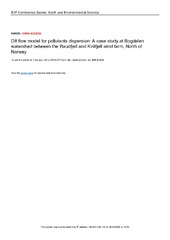Blar i forfatter Artikler, rapporter og annet (teknologi og sikkerhet) "Bui, Minh Tuan"
-
D8 flow model for pollutants dispersion: A case study at Bogdalen watershed between the Raudfjell and Kvitfjell wind farm, North of Norway
Bui, Minh Tuan; Lu, Jinmei (Journal article; Tidsskriftartikkel; Peer reviewed, 2019)Investments in wind power are booming in Norway. Several wind power plants have been constructed to exploit the wind energy. However, construction of wind farms has potential impacts on the surrounding environment. Particularly, waste from construction site or activities of workers, leakage of oil and chemical would spread into the nearby waterbodies by runoff or infiltrating into ground. Hence, ... -
Evaluating the effects of watershed subdivision on hydrological simulation by SWAT model in an Arctic watershed
Bui, Minh Tuan; Lu, Jinmei; Nie, Linmei (Journal article; Tidsskriftartikkel; Peer reviewed, 2020-12-04)The hydrological model SWAT is a state-of-the-art tool for environmental and water resources management. Like other semi-distributed models, the whole river basin in the SWAT model is delineated into smaller sub-basins prior to conducting the simulation. Watershed delineation is an importance step since it could potentially influence the modelling results. The present study aimed to conducte an ... -
Evaluation of the Climate Forecast System Reanalysis data for hydrological model in the Arctic watershed Målselv
Bui, Minh Tuan; Lu, Jinmei; Nie, Linmei (Journal article; Tidsskriftartikkel; Peer reviewed, 2021-04-13)The high-resolution Climate Forecast System Reanalysis (CFSR) data have recently become an alternative input for hydrological models in data-sparse regions. However, the quality of CFSR data for running hydrological models in the Arctic is not well studied yet. This paper aims to compare the quality of CFSR data with ground-based data for hydrological modeling in an Arctic watershed, Målselv. The ... -
Evaluation of the water quality at Bogdalen watershed near Kvitfjell and Raudfjell wind farm area
Lu, Jinmei; Bui, Minh Tuan; Yuan, Fuqing (Journal article; Tidsskriftartikkel; Peer reviewed, 2019)Wind energy is one of the important renewable energies that get fast development in recent years. The development of wind turbines can have potential environmental impact on the surrounding environment. Especially when the wind turbines are built near the watersheds, water quality in the watershed may be degraded. In this study, the water quality in Bogdalen watershed that in or surrounding Kvitfjell ... -
Quantifying the effects of watershed subdivision scale and spatial density of weather inputs on hydrological simulations in a Norwegian Arctic watershed
Bui, Minh Tuan; Lu, Jinmei; Nie, Linmei (Journal article; Tidsskriftartikkel; Peer reviewed, 2021-12-01)The effects of watershed subdivisions on hydrological simulations have not been evaluated in Arctic conditions yet. This study applied the Soil and Water Assessment Tool and the threshold drainage area (TDA) technique to evaluate the impacts of watershed subdivision on hydrological simulations at a 5,913-km<sup>2 </sup>Arctic watershed, Målselv. The watershed was discretized according to four TDA ... -
A Review of Hydrological Models Applied in the Permafrost-Dominated Arctic Region
Bui, Minh Tuan; Lu, Jinmei; Nie, Linmei (Journal article; Tidsskriftartikkel; Peer reviewed, 2020-10-06)The Arctic region is the most sensitive region to climate change. Hydrological models are fundamental tools for climate change impact assessment. However, due to the extreme weather conditions, specific hydrological process, and data acquisition challenges in the Arctic, it is crucial to select suitable hydrological model(s) for this region. In this paper, a comprehensive review and comparison of ... -
Sensitivity analysis of the SWAT model to spatial distribution of precipitation in streamflow simulation in an Arctic watershed
Bui, Minh Tuan; Lu, Jinmei; Nie, Linmei (Journal article; Tidsskriftartikkel; Peer reviewed, 2020-12-04)This study approached a physically based, semi-distributed SWAT model to test the model sensitivity to the spatial distribution of precipitation. Ten scenarios of precipitation from five scattered rain gauges in an Arctic watershed Målselv in northern Norway were used as inputs to run the SWAT model. Streamflows were simulated. The model runs at monthly time interval based on the historical data of ...


 English
English norsk
norsk





